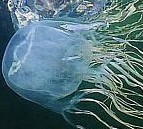-

"hibiscustour", three separate sites -
Islands and lagoons New Caledonia, Polynesia (part). -

Curiosity. Things, amazing, science, society.. -

Ideas perso. Household, Practical life, D.I.Y, Computering..
 
but reality |
  |
|
|
|
Inside the lagoon, could be dangerous : sharks, barracudas, muraena et aiguillettes (plusieurs accidents/an par celles-ci); peuvent être touchés : poisson pierre (rare), rascasse, chirurgien, cônes, serpent (? voir fond doc), méduses, oursin blanc, poisson ballon (tétraodon, ou fugu en japonais)
|
if you see a tooth like that, you will have really much chance, the more so as this one is false out of resin! |
Left hand. Small
shark
of the lagoon (1,5 m). Keep an eye on it but no
dangerous in theory, unlike its
cousins (white shark, tiger-carcharinus). outside the reef. Grey shark (carcharinus), Can stay still in the passes and what not, venture around inside. |
|
|

|
Fascinating but not very sympathetic, the jellyfish seem multiplying and invading seas and oceans.
Each year, beaches are prohibited and cycles are seemingly narrowing.
As usual, climatic warmer waters would be the first explanation, but others say the issue is the serious imbalance we have caused by overfishing. Their natural predators have disappeared or nearly so. |
Jelly fish are composed of 98% water ; they think at occasionally utilise them for irrigation, burying them in the soil. The Japanese are developing sodas and ice cream to make a change from soups and salads - jellyfish ones of course - already popular in China, where one chew about anything and where jelly fish dried are commonly sold. What can subsist from 98% water ? sort of large chips I have seen on the TV |
The last but not the least, here is a mutation of the starfishAcanthaster
Il s'agit du fruit de la bardane, bien connu des promeneurs qui s'énvoient ces agrippantes petites boules (le fond a été remplacé).
L'idée du velcro provient d'une toute petite plante qui se colle fortement sur les chaussettes, avec de minuscules crochets.

![]() Coral 1 (origin, sea, depth, madreporia, corals and madreporia, tentacles..)
Coral 1 (origin, sea, depth, madreporia, corals and madreporia, tentacles..)
The lagoon (origin and formation, kind of reefs, passes, islets/motus)
Lagoon life 1 (fish and reef vivid beings)
Lagoon life 2 next (fish and reef vivid beings)
Lagoon life 3 next ( reef vivid beings, unsafe fish and other animals)
